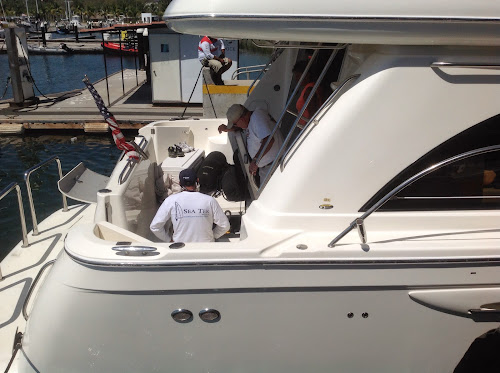So excited to get Janabanana back in the water today!
I walked to the shipyard at about 9:30. Lift was set up under JB and they were taking the supports out from underneath the boat.
The bow looks perfect
The props have been painted with Speed Prop. Expensive treatment that keeps barnacles from sticking on.
Looks good, right? No, not so good, read on.....
Here she comes.
Time to back up
Gates are open
Almost there, lots of help now.
Slowly, gently...
Low enough now for us to get on.
My turn. Peter and Javier of Sea Tek are getting on with us.
All aboard!
Down and back we go.
We need to test the thrusters before they release us to make sure they work.
Javier hops down in the bilge to secure the batteries and bolt them in.
Ready to pull away now. Untying lines.
Tuesday, February 01, 2011
By Leonardo Montoya, Rice Propulsion, in the Januaryedition of MarineNews
The graphic shows the chamfering that goes from a0.5 or 0.4 radius to the tip of suction side
Yes, sometimes they sing: Some propellers in serviceproduce a high-pitched noise, often referred to as“singing.”
This sound typically is a clear harmonic tone much like a humming or a ringing wine glass.
More of an annoyance than anything harmful, the causes of singing are not completely understood. Many theories havebeen put forward to account for the phenomenon of singing, but it appears to be affected by critical factors for which thetheories make no allowance.
For instance, in some cases when a twin-screw vessel has one propeller that sings, the noise is eliminated just byswitching the position of the propellers, or by replacing the propeller with an identical spare. Also, the fewer blades thepropeller has, the less cases of singing are observed.
Mitigation of Singing: the Anti-Singing Edge
The singing is a function of propeller diameter and RPMs, boat speed and trailing-edge size (thickness) and roundness.In most of the cases, not much can be done on diameter, RPMs or speed, but we can modify the edge geometry. Thishas been the strategy for all efforts to eliminate singing.
Most propeller professionals (and others) are familiar with the anti-singing edge, a chamfering of the trailing edge,typically on the suction side. The intent of this shape is to avoid the creation of curving flow eddies by cleanly separating
the flow off of the blade.
However the adoption of unduly thin edges can result in erosion or fracture of the blade near the edges. It is advised thatan anti-sing edge be considered as a last resort to minimize the singing of an existing propeller.

















No comments:
Post a Comment